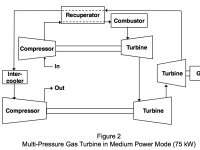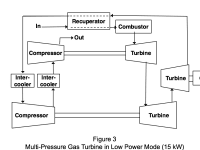Multi-Pressure Gas Turbines
Multi-pressure gas turbines are modified versions of intercooled recuperated gas turbines (ICRs). They extend the more than 40% efficiency of ICRs at medium and high power down into the 5% power range. They are practical for automobiles that must operate efficiently at the very low power required for highway cruising or stop-and-go city driving, yet still need the high power necessary for passing, accelerating and hill climbing.
Multi-pressure gas turbines retain the ability of production microturbines to meet all emission regulations without after treatment. They operate on a wide range of gaseous and liquid fuels offering light weight, long life, low noise, and very low maintenance.
The first ICRs were demonstrated by Ford about 1964. Today, they power British Type 45 destroyers using Rolls-Royce WR-21s. Today, ICRTec is demonstrating ICRs in Class 8 trucks. In both, efficiency is comfortably over 40% at medium and high loads.
Starting with a conventional recuperated gas turbine, ICRs add an intercooler and second compressor/turbine rotor (Figure 1). In high power mode, multi-pressure gas turbines are simply ICRs.
In medium power mode (Figure 2), ambient air enters directly into the high pressure compressor inlet instead of the low pressure compressor. Mass flow and therefore gas turbine power are reduced by a ratio equal to the pressure ratio of the low pressure compressor. The power turbine now exhausts into a partial vacuum. The exhaust is cooled in the intercooler, compressed in the low pressure compressor and discharged to atmosphere.
Efficiency at each percentage load remains the same. If the low pressure compressor has a 3:1 pressure ratio, having the air enter the high pressure compressor reduces all pressures and mass flows throughout the cycle and therefore full load and part load power by a factor of three. If the basic gas turbine had been rated at 225 kW, it is now rated at 75 kW, but with the same efficiency.
With more complex valving and a second intercooler, ambient air can enter directly into the recuperator (Figure 3). Assuming pressure ratios of 3:1 and 5:1 for the low and high pressure compressors, a 225 kW gas turbine can operate as a 75 kW or a 15 kW gas turbine with identical efficiency curves in all three modes. This is equivalent to operating at sea level, 27,500 feet and 61,500 feet.
Transition is accomplished with valves commonly used in vehicles with twin turbochargers. All valves operate on the cold or compressor side. With only a mass flow change and no rpm or temperature change, there is no mechanical or thermal shock during transition. Transition is essentially instantaneous with no turbo-lag.
The rotating groups are basically three turbochargers, one of which has a gearbox (or a generator) replacing the compressor. The recuperator is similar to those in production. The intercooler(s) and valves are production items. The cost in automotive quantities will be low reducing the cost of vehicles while cutting emissions.
U.S. patents 6,526,757 and 6,606,864 are applicable.
Like this entry?
-
About the Entrant
- Name:Robin Mackay
- Type of entry:individual
- Patent status:patented








